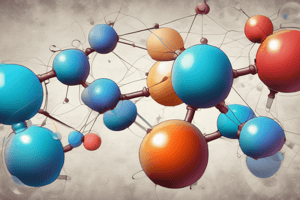Podcast
Questions and Answers
What is the smallest unit of matter that still retains the properties of an element?
What is the smallest unit of matter that still retains the properties of an element?
- Compound
- Mixture
- Atom (correct)
- Molecule
What is the process by which atoms gain or lose electrons to form ions?
What is the process by which atoms gain or lose electrons to form ions?
- Electronegativity
- Ionization (correct)
- Electrolysis
- Ionization energy
Which of the following types of bonds is characterized by the sharing of electrons between atoms?
Which of the following types of bonds is characterized by the sharing of electrons between atoms?
- Electrostatic bond
- Covalent bond (correct)
- Ionic bond
- Hydrogen bond
What is the term for the attraction between two atoms that share a pair of electrons?
What is the term for the attraction between two atoms that share a pair of electrons?
What is the term for the energy required to remove an electron from an atom in its ground state?
What is the term for the energy required to remove an electron from an atom in its ground state?
What is the main difference between an atom and a molecule?
What is the main difference between an atom and a molecule?
What happens to the electron arrangement of an atom when it gains or loses electrons?
What happens to the electron arrangement of an atom when it gains or loses electrons?
Which of the following types of bonds is characterized by the transfer of electrons between atoms?
Which of the following types of bonds is characterized by the transfer of electrons between atoms?
What is the term for the energy change associated with the formation of a covalent bond?
What is the term for the energy change associated with the formation of a covalent bond?
Which of the following statements about electrons is true?
Which of the following statements about electrons is true?
Flashcards are hidden until you start studying
Study Notes
Atomic Structure
- The smallest unit of matter that still retains the properties of an element is an atom.
Ion Formation
- Atoms gain or lose electrons to form ions through a process called ionization.
Chemical Bonding
- Covalent bonds are characterized by the sharing of electrons between atoms.
- The attraction between two atoms that share a pair of electrons is known as a covalent bond.
- The term for the attraction between two atoms that share a pair of electrons is also referred to as electron pair bond.
Energy and Electrons
- The energy required to remove an electron from an atom in its ground state is known as ionization energy.
Atomic Structure
- The smallest unit of matter that still retains the properties of an element is an atom.
Ion Formation
- Atoms gain or lose electrons to form ions through a process called ionization.
Chemical Bonding
- Covalent bonds are characterized by the sharing of electrons between atoms.
- Electrons shared between atoms form a chemical bond, with the attraction between the atoms being called a covalent bond.
- Ionic bonds, on the other hand, are formed through the transfer of electrons between atoms.
Energy and Electrons
- The energy required to remove an electron from an atom in its ground state is called ionization energy.
- The energy change associated with the formation of a covalent bond is called bond energy.
Atoms vs. Molecules
- The main difference between an atom and a molecule is that an atom is a single unit of an element, while a molecule is a group of two or more atoms bonded together.
Electron Arrangement
- When an atom gains or loses electrons, its electron arrangement changes, resulting in the formation of ions.
Electron Properties
- One true statement about electrons is that they are involved in chemical bonding through sharing or transfer.
Studying That Suits You
Use AI to generate personalized quizzes and flashcards to suit your learning preferences.




